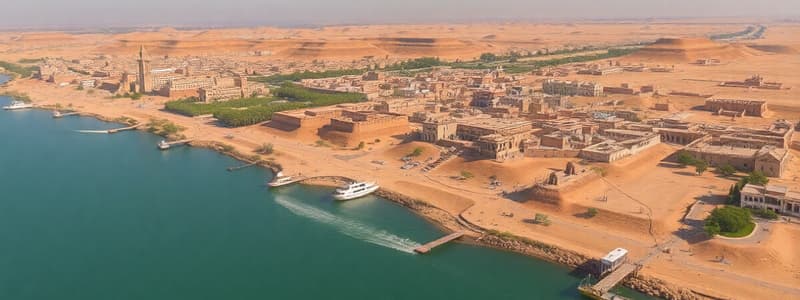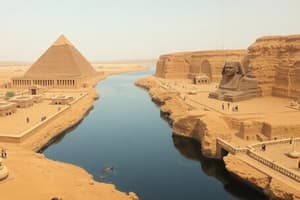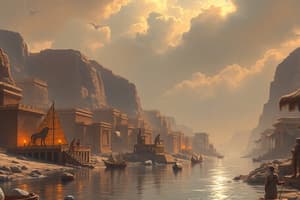Podcast
Questions and Answers
The Nile River flows from highlands in eastern Africa to the ______.
The Nile River flows from highlands in eastern Africa to the ______.
Mediterranean Sea
King Menes established the first unified kingdom in ______.
King Menes established the first unified kingdom in ______.
Egypt
The ancient civilization that began around 3500 BC in the Nile Valley is known as the ancient ______.
The ancient civilization that began around 3500 BC in the Nile Valley is known as the ancient ______.
Egyptian
The city of ______ served as the capital of the pharaohs for a long period.
The city of ______ served as the capital of the pharaohs for a long period.
The Nile River is approximately ______ km long, making it the longest river in the world.
The Nile River is approximately ______ km long, making it the longest river in the world.
Ancient Egyptians built cities like Memphis and ______ to meet their needs.
Ancient Egyptians built cities like Memphis and ______ to meet their needs.
Memphis was located near the ______ River.
Memphis was located near the ______ River.
The neighboring cultural group influenced by the Egyptians were the ______.
The neighboring cultural group influenced by the Egyptians were the ______.
The city of Memphis was a significant commercial and ______ center.
The city of Memphis was a significant commercial and ______ center.
Prominent modern countries near the Nile Valley include Egypt and ______.
Prominent modern countries near the Nile Valley include Egypt and ______.
Ancient Egyptians constructed buildings primarily from ______ and stone.
Ancient Egyptians constructed buildings primarily from ______ and stone.
The pharaoh commissioned the construction of grand ______ as tombs for himself and royalty.
The pharaoh commissioned the construction of grand ______ as tombs for himself and royalty.
Numerous temples were located throughout the city, with the largest dedicated to ______.
Numerous temples were located throughout the city, with the largest dedicated to ______.
Pyramids were constructed in the ______.
Pyramids were constructed in the ______.
The construction of the pyramids highlighted the importance of workers' knowledge, skills, and ______ during the process.
The construction of the pyramids highlighted the importance of workers' knowledge, skills, and ______ during the process.
The ancient Egyptians believed that the pharaoh was the representative of the ______ on earth.
The ancient Egyptians believed that the pharaoh was the representative of the ______ on earth.
In ancient Egypt, a ______ was established to manage government administration.
In ancient Egypt, a ______ was established to manage government administration.
Hatshepsut ruled Egypt from ______ to 1458 BC.
Hatshepsut ruled Egypt from ______ to 1458 BC.
Criminals who committed serious offenses in ancient Egypt were often ______.
Criminals who committed serious offenses in ancient Egypt were often ______.
Egyptians could become ______ by studying language, mathematics, and religion in schools.
Egyptians could become ______ by studying language, mathematics, and religion in schools.
The highest authority in ancient Egyptian society was the ______.
The highest authority in ancient Egyptian society was the ______.
The second level of the hierarchy included royal members, prime ministers, and ______.
The second level of the hierarchy included royal members, prime ministers, and ______.
Merchants and craftsmen belonged to the ______ level of the social hierarchy.
Merchants and craftsmen belonged to the ______ level of the social hierarchy.
At the bottom of the social hierarchy were the ______.
At the bottom of the social hierarchy were the ______.
The pyramid diagram illustrates a clear division between the ______ class and the governed class.
The pyramid diagram illustrates a clear division between the ______ class and the governed class.
The ancient Egyptians believed in many ______.
The ancient Egyptians believed in many ______.
Amun was initially a local god who later became combined with the Sun God ______.
Amun was initially a local god who later became combined with the Sun God ______.
Osiris is known as the God of ______ and the Underworld.
Osiris is known as the God of ______ and the Underworld.
Horus is recognized as the son of Osiris and the God of the ______.
Horus is recognized as the son of Osiris and the God of the ______.
The Abu Simbel Temples were built in the 13th century ______.
The Abu Simbel Temples were built in the 13th century ______.
The ancient Egyptians created ______ for the deceased to preserve their bodies.
The ancient Egyptians created ______ for the deceased to preserve their bodies.
The mummification process took approximately ______ days to complete.
The mummification process took approximately ______ days to complete.
Salt and various ______ were used to preserve the body and its wrappings.
Salt and various ______ were used to preserve the body and its wrappings.
Internal organs were removed, dried, and stored in ______ to prevent decay.
Internal organs were removed, dried, and stored in ______ to prevent decay.
The ancient Egyptians were skilled in refining metals through their knowledge of ______.
The ancient Egyptians were skilled in refining metals through their knowledge of ______.
An assistant used fine ______ to wrap the body during the mummification process.
An assistant used fine ______ to wrap the body during the mummification process.
The Egyptians developed a calendar system by observing star movements and the ______ cycle.
The Egyptians developed a calendar system by observing star movements and the ______ cycle.
Egyptians performed surgeries and used herbal remedies in their practice of ______.
Egyptians performed surgeries and used herbal remedies in their practice of ______.
Around 3000 BC, ancient Egyptians used reeds to create ______ for writing.
Around 3000 BC, ancient Egyptians used reeds to create ______ for writing.
The invention of the ______ and water clock were important advancements for measuring time in ancient Egypt.
The invention of the ______ and water clock were important advancements for measuring time in ancient Egypt.
The ancient Egyptians invented ______ around 3500 BC.
The ancient Egyptians invented ______ around 3500 BC.
Around 1780 BC, hieroglyphics were simplified to ______.
Around 1780 BC, hieroglyphics were simplified to ______.
By around 650 BC, hieratic was further simplified into ______.
By around 650 BC, hieratic was further simplified into ______.
The ancient Egyptians developed a ______ system and a decimal system.
The ancient Egyptians developed a ______ system and a decimal system.
Jean-François ______ deciphered some of the words on the Rosetta Stone in 1822.
Jean-François ______ deciphered some of the words on the Rosetta Stone in 1822.
Flashcards
Ancient Egyptian Civilization
Ancient Egyptian Civilization
The first unified kingdom in Egypt, established by King Menes around 3200 BC.
Memphis
Memphis
The capital of the pharaohs for a long time, Memphis was a bustling city with a population of about 30,000 at its peak.
Ancient Egyptian Cities
Ancient Egyptian Cities
Ancient Egyptians built cities like Memphis and Thebes for political and religious reasons, and smaller cities near pyramids for construction workers.
Memphis - Commercial and Handicraft Center
Memphis - Commercial and Handicraft Center
Signup and view all the flashcards
Memphis - Connection to the Nile
Memphis - Connection to the Nile
Signup and view all the flashcards
What is the length and location of the Nile River?
What is the length and location of the Nile River?
Signup and view all the flashcards
Who inhabited the Nile Valley and when did the Egyptian Civilization begin?
Who inhabited the Nile Valley and when did the Egyptian Civilization begin?
Signup and view all the flashcards
How were the Kushites influenced by the Egyptians?
How were the Kushites influenced by the Egyptians?
Signup and view all the flashcards
What are Upper and Lower Egypt?
What are Upper and Lower Egypt?
Signup and view all the flashcards
Name some important cities within the Nile Valley.
Name some important cities within the Nile Valley.
Signup and view all the flashcards
Building Materials in Ancient Egypt
Building Materials in Ancient Egypt
Signup and view all the flashcards
Ancient Egyptian Architectural Skills
Ancient Egyptian Architectural Skills
Signup and view all the flashcards
Purpose of Pyramids
Purpose of Pyramids
Signup and view all the flashcards
Temples in Ancient Egypt
Temples in Ancient Egypt
Signup and view all the flashcards
Location of Pyramids
Location of Pyramids
Signup and view all the flashcards
Pharaoh
Pharaoh
Signup and view all the flashcards
Royal members, prime minister, priests
Royal members, prime minister, priests
Signup and view all the flashcards
Nobles & Scribes
Nobles & Scribes
Signup and view all the flashcards
Merchants & Craftsmen
Merchants & Craftsmen
Signup and view all the flashcards
Farmers
Farmers
Signup and view all the flashcards
Who was the pharaoh?
Who was the pharaoh?
Signup and view all the flashcards
What was civil government in ancient Egypt?
What was civil government in ancient Egypt?
Signup and view all the flashcards
Who became pharaoh after the previous one died?
Who became pharaoh after the previous one died?
Signup and view all the flashcards
Who was Hatshepsut?
Who was Hatshepsut?
Signup and view all the flashcards
What was a scribe in ancient Egypt?
What was a scribe in ancient Egypt?
Signup and view all the flashcards
Ancient Egyptian Beliefs
Ancient Egyptian Beliefs
Signup and view all the flashcards
Patron Gods
Patron Gods
Signup and view all the flashcards
Pharaoh's Divinity
Pharaoh's Divinity
Signup and view all the flashcards
Amun: King of the Gods
Amun: King of the Gods
Signup and view all the flashcards
Osiris: God of the Underworld
Osiris: God of the Underworld
Signup and view all the flashcards
Why did Egyptians mummify their dead?
Why did Egyptians mummify their dead?
Signup and view all the flashcards
How long did mummification take?
How long did mummification take?
Signup and view all the flashcards
Describe the steps of mummification.
Describe the steps of mummification.
Signup and view all the flashcards
Who could afford mummification?
Who could afford mummification?
Signup and view all the flashcards
What happened to the internal organs during mummification?
What happened to the internal organs during mummification?
Signup and view all the flashcards
Hieroglyphics
Hieroglyphics
Signup and view all the flashcards
Hieratic
Hieratic
Signup and view all the flashcards
Demotic
Demotic
Signup and view all the flashcards
Ancient Egyptian Measurement System
Ancient Egyptian Measurement System
Signup and view all the flashcards
Champollion's Contribution
Champollion's Contribution
Signup and view all the flashcards
Ancient Egyptian Metallurgy
Ancient Egyptian Metallurgy
Signup and view all the flashcards
Ancient Egyptian Brewing
Ancient Egyptian Brewing
Signup and view all the flashcards
Ancient Egyptian Medicine
Ancient Egyptian Medicine
Signup and view all the flashcards
Ancient Egyptian Calendar
Ancient Egyptian Calendar
Signup and view all the flashcards
Ancient Egyptian Timekeeping
Ancient Egyptian Timekeeping
Signup and view all the flashcards



